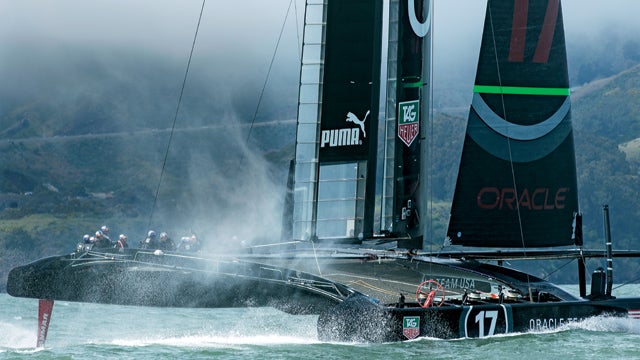RUSSELL COUTTS looks tired. It’s an early summer afternoon in San Francisco, and I’m seated across from the 51-year-old Kiwi sailing legend inside Pier 80, the cavernous warehouse that serves as the base of operations for
Coutts, who won three America’s Cups as a skipper of other teams before software mogul Larry Ellison hired him to be the CEO of Oracle Racing in 2007, has good reason to be fatigued. He spent the better part of the morning playing host to a big-dollar corporate partner. More significantly, for the past six weeks he’s been a media punching bag.
On May 9, the Swedish team Artemis, a challenger for the 2013 Cup, flipped its AC72 catamaran on the San Francisco Bay during training. The superfast carbon-fiber craft, 72 feet long and powered by a 13-story-tall rigid wing instead of a soft mainsail, broke apart—the front beam connecting the hulls snapped, causing the boat to fold in half.
Crew member Andrew Simpson, a 36-year-old British Olympic gold medal sailor, was trapped under the wreckage and drowned. The incident turned a rising wave of public criticism about this year’s America’s Cup into a full-on tsunami. The prime target was Ellison, the recalcitrant billionaire who won the 2010 Cup, earning the right to set the rules and transform the event with the superfast AC72s. Ellison refused to respond publicly, which meant that Coutts bore much of the impact.
Oracle, critics charged, got everything wrong. The switch from traditional monohull yachts to high-speed catamarans alienated the event’s core fans and sponsors. Plans for sprawling spectator venues plus extensive redevelopment along the San Francisco waterfront were overcooked and, predictably, eventually dialed way back.
The AC72 design was so expensive that challengers had to spend a reported $65 million to $100 million just to participate, with the result being that only three teams would compete in the , the summer qualifying series on the bay that would determine who takes on Oracle in the America’s Cup Finals this month. (In the previous Louis Vuitton, in 2007, 11 teams raced.) Although the boats were thrillingly fast—the AC72 can approach 50 miles per hour with its hulls flying above the water on hydrofoils—they were “simply too dangerous for competition,” as one reporter put it.
When I repeat all this to Coutts, he runs a hand through his tightly cropped graying hair and sneers. The financial difficulties, he insists, have been mostly due to the economy. Sure, in hindsight he would have opted for smaller, cheaper craft, but the international committee that created the AC72 had been “worried about the boat being too small for the America’s Cup,” he says. “We didn’t want it to look like a weekend club event.”
Having only three teams in the Louis Vuitton is a major disappointment, but it doesn’t matter much, because “most Americans aren’t interested in the preliminary races.” Either way, he insists, high-speed catamarans were absolutely the right choice. To nonsailors, traditional America’s Cup races “were fricking boring—like watching paint dry.”
That point goes to the heart of what is really happening with the America’s Cup. What’s gotten lost in all the sniping over economics and boat design is the underlying cultural revolution Ellison and Coutts ignited when, as Coutts famously stated in 2010, they planned to create an event to “meet the expectations of the Facebook generation, not the Flintstone generation.” They’ve stumbled badly in their effort, to be sure. But converting the Cup from a clubby pastime into an action-sports spectacle was bound to be painful.
A radical transition was also necessary to keep the sport relevant, and despite all the disappointments, when the Finals kick off on the San Francisco Bay in September, chances are Americans will be gripped by sailing action for the first time since Dennis Connor piloted the Stars and Stripes to victory in the late eighties. The race hasn’t been broadcast on network television here since 1995; the 2010 race in Spain, between Oracle and Swiss-Italian billionaire Ernesto Bertarelli’s Alinghi team, didn’t even get cable coverage. Most of the headlines about the sport in recent years have been about lawsuits.
The introduction of scary-fast boats instantly changed the narrative to the X-Games-ification of the Cup. (Sailors now must wear helmets and, since Simpson’s death, body armor and air canisters.) One hint that it might work is the interest this year’s event has garnered from youth-minded brands. Puma is the official apparel sponsor. Red Bull, in addition to being an Oracle partner, is footing the bill for the , a four-day series coming just before the Finals that has sailors aged 19 to 24 racing on AC45s, smaller versions of the big catamarans.
A few days before I sat down with Coutts, I watched a helicopter camera crew shoot a race on the bay between one of Oracle’s AC72s and 20-year-old Red Bull kiteboarder Kai Lenny. Earlier in the spring, sailors shared Vine video snippets of snowboarder
Meanwhile, even Ellison’s staunchest critics concede that he’s got the TV product right. During the America’s Cup World Series, an AC45 race-circuit-cum-marketing-project launched in 2011 to gin up interest in the new style of racing, some 250 million international viewers watched TV footage captured by choppers and hi-def cameras mounted on boats and sailors.
A sophisticated software system called allows producers to insert all manner of digital graphics into footage, from start and finish lines to wind direction and angles of attack. LiveLine won an Emmy in 2011, and a June 2012 broadcast on NBC of a World Series event in Newport, Rhode Island, got better Nielsen ratings than the Tour de France. Still, the network paid nothing for the rights to air the America’s Cup Finals this September 7 and 8. Quite the opposite: to guarantee live coverage, the event’s managers had to purchase substantial commercial time, which they then offered to sponsors.
In June, the bad news and bad press kept coming. Artemis announced that it needed more time to prepare its second AC72 and would skip the early rounds of the Louis Vuitton, joining the other two challengers, Emirates New Zealand and Italian team Luna Rossa, during the semifinals in August. In response, officials refunded thousand of tickets and decided not to erect planned grandstand seating until the Finals. “By letting his monopolistic impulses loose on his favorite sport,” wrote of Ellison, “he’s well on his way to defending his own 2010 America’s Cup victory by driving all other prospective competitors out of business.”
Pundits traded guesses about what might go wrong next. If another AC72 went down, would the Louis Vuitton be canceled altogether? ran an op-ed by a veteran sailing writer calling on Ellison to give up on “the overpowered beasts.”
Back inside Pier 80, I ask Coutts about the ultimate disaster scenario. What if the America’s Cup Finals end on the first day with an AC72 disintegrating on live TV?
“If that happened in race one, it would be a huge moment,” Coutts responds. “I don’t think it’d be a disaster at all.” He laughs, but it’s no joke. The reality is, the risk of a catastrophe is one of the biggest reasons people are paying attention to sailing again. Very soon, we’ll know if those coming to see a crash—or tuning in because they saw sick Facebook footage of an AC72 racing a kiteboarder—might actually be willing to stick around for a regatta.


